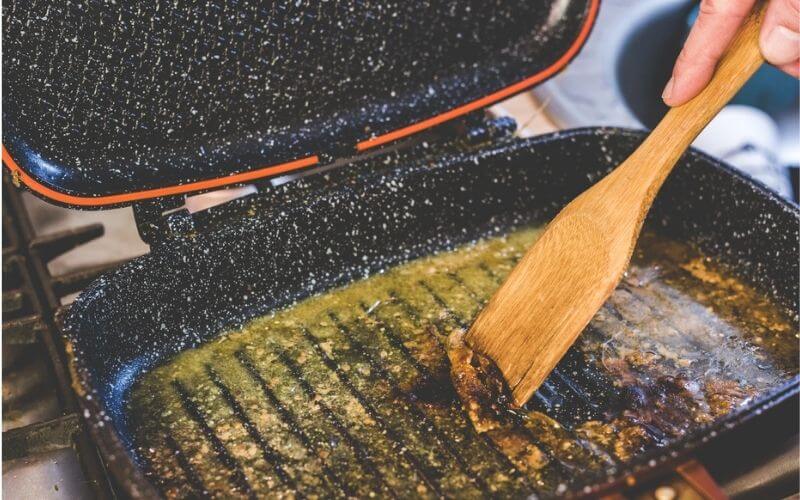To clean a Teflon griddle, use a non-abrasive sponge and mild dish soap. A Teflon griddle is a versatile cooking tool that can be used for making pancakes, eggs, and other delicious meals.
However, it’s important to keep the griddle clean to avoid any buildup of oils or food residue. Cleaning a Teflon griddle is a simple process that requires only a few basic steps. In this article, we will discuss the best methods to clean a Teflon griddle, ensuring its longevity and maintaining its non-stick properties.
So, let’s dive in and learn how to clean a Teflon griddle effectively.

Credit: boatbasincafe.com
Introduction To Cleaning A Teflon Griddle
Understanding The Importance Of Regular Cleaning
Cleaning your Teflon griddle regularly is essential to maintain its performance and prolong its lifespan. By removing built-up grease, food residue, and stains, you not only ensure a clean cooking surface but also prevent potential health risks. Here are the key points to understand about the importance of regular cleaning:
- Prevents cross-contamination: Regular cleaning eliminates the risk of cross-contamination, as bacteria from previous meals can transfer to your new dishes.
- Ensures even heat distribution: A clean Teflon griddle allows for even heat distribution, ensuring your food cooks evenly and preventing any hotspots.
- Maintains the non-stick properties: Cleaning your griddle regularly prevents the Teflon coating from deteriorating and losing its non-stick properties over time.
- Improves the taste of your food: A clean griddle will enhance the flavor of your cooked food by eliminating any residual flavors or odors from previous meals.
- Prevents smoke and flare-ups: Accumulated grease and food debris can cause smoke and flare-ups during cooking, which can affect both the taste and safety of your food.
Benefits Of Proper Maintenance
Proper maintenance of your Teflon griddle goes beyond regular cleaning. It includes taking the necessary steps to ensure its longevity and optimal performance. Here are the key benefits of proper maintenance:
- Extends the lifespan: By following proper maintenance practices, you can significantly extend the lifespan of your Teflon griddle, saving you money in the long run.
- Preserves the non-stick surface: Consistent maintenance prevents scratches and damage to the Teflon coating, maintaining its non-stick surface and making your cooking experience more enjoyable.
- Facilitates easy cleaning: With proper maintenance, your griddle will be easier to clean, requiring less effort and time to remove any residue or stains.
- Reduces the risk of damage: By addressing any issues promptly and performing regular check-ups, you can avoid potential damages to your griddle, such as warping or corrosion.
- Enhances safety: Proper maintenance ensures that your griddle operates safely, reducing the risk of accidents or malfunctions during cooking.
Regular cleaning and proper maintenance of your Teflon griddle are vital for optimal performance, longevity, and ensuring safe and delicious meals. By understanding the importance of regular cleaning and the benefits of proper maintenance, you can enjoy the full potential of your griddle and enhance your culinary experience.
Materials Needed For Cleaning A Teflon Griddle
Gathering The Necessary Supplies
To clean a Teflon griddle effectively, it’s important to have the right materials on hand. Here are the recommended supplies you’ll need:
- Mild dish soap: Choose a gentle dish soap that is specifically formulated for non-stick surfaces. Harsh chemicals can damage the Teflon coating on the griddle.
- Warm water: Use warm water to help loosen and remove any stuck-on food particles.
- Soft sponge or cloth: Opt for a non-abrasive sponge or cloth to avoid scratching the delicate Teflon coating. Avoid using steel wool or abrasive scrubbers as they can cause damage.
- Plastic or wooden utensils: When cleaning, use plastic or wooden spatulas or utensils to avoid scratching the griddle’s surface. Metal utensils should be avoided as they can chip or scratch the Teflon coating.
- Paper towels or clean cloth: These can be used to dry off the griddle after cleaning, helping to prevent the formation of water spots.
- Vinegar or lemon juice: If there are any tough stains or burnt-on areas, a mixture of equal parts vinegar or lemon juice and water can be used as a natural cleaning solution.
Recommended Cleaning Tools And Products
When it comes to cleaning a Teflon griddle, it’s essential to have the right tools and products to ensure a thorough and safe cleaning process. Here are our top recommendations:
- Silicone spatula: A silicone spatula is perfect for gently scraping off any food residue without scratching the Teflon surface.
- Nylon bristle brush: For stubborn stains or hard-to-reach areas, a nylon bristle brush can be used to scrub the griddle gently.
- Non-abrasive cleaner: Look for cleaners specifically designed for Teflon or non-stick surfaces. These cleaners are formulated to remove grease and stains without damaging the coating.
- Microfiber cloth: A microfiber cloth is ideal for drying off the griddle and polishing it to a streak-free shine.
- White vinegar: White vinegar is a versatile cleaning agent that can effectively remove stubborn stains and grease from the griddle.
- Baking soda: Baking soda mixed with warm water can act as a gentle abrasive cleaner for removing tough stains and burnt-on food.
- Toothbrush: A soft-bristled toothbrush can come in handy when cleaning hard-to-reach corners and crevices on the griddle.
Importance Of Using Non-Abrasive Materials
When cleaning a Teflon griddle, it’s crucial to use non-abrasive materials to avoid damaging the delicate Teflon coating. Here’s why:
- Preserves the non-stick coating: Teflon griddles have a non-stick coating that can easily scratch and peel if abrasive materials are used. Using non-abrasive materials helps preserve the integrity of the coating and extends the lifespan of the griddle.
- Prevents food from sticking: The main purpose of a Teflon griddle is to provide a non-stick surface for cooking. Scratches on the Teflon coating can cause food to stick, making it difficult to clean and affecting the overall cooking experience.
- Avoids chemical reactions: Abrasive materials or harsh cleaners can react with the Teflon coating, causing it to break down and release toxic fumes. By using non-abrasive materials, you reduce the risk of chemical reactions and ensure a safe cooking environment.
Remember, taking proper care of your Teflon griddle by using the right cleaning tools and materials will help maintain its longevity and performance, ensuring many delicious meals to come.
Step-By-Step Instructions For Cleaning A Teflon Griddle
Maintaining a clean and hygienic cooking surface is key to achieving delicious and healthy meals on your Teflon griddle. Follow these simple steps to keep your griddle in pristine condition:
Preparing The Griddle For Cleaning
Before you begin the cleaning process, it is essential to prepare the Teflon griddle to ensure effective results. Here’s what you need to do:
- Allow the griddle to cool down completely after use to avoid any accidental burns.
- Disconnect the griddle from the power source and remove any detachable parts, such as the drip tray or grease collection tray.
- Gently scrape off any excess grease or food particles using a spatula or scraper.
Removing Excess Grease And Food Particles
To achieve optimal cleaning results, it is important to remove any excess grease and food particles. Follow these steps:
- Wipe off any loose debris from the surface with a dry paper towel or cloth.
- Use a non-abrasive brush or sponge to scrub away any stuck-on grease or food particles.
- If needed, apply a small amount of mild dish soap to the brush or a sponge and gently scrub the surface, focusing on the areas with stubborn residue.
- Rinse off the griddle thoroughly with warm water to remove any soap residue.
Safely Using Cleaning Solutions On Teflon Surfaces
When it comes to cleaning Teflon surfaces, it is crucial to use cleaning solutions that are safe and won’t damage the non-stick coating. Here’s what you should do:
- Avoid using abrasive cleaners, metal scouring pads, or harsh chemicals as these can cause scratches or damage to the Teflon surface.
- Opt for gentle cleaning solutions such as a mixture of warm water and mild dish soap.
- If there are tougher stains or grease, consider using a specialized Teflon-safe cleaning solution specifically designed for non-stick surfaces.
Scrubbing Techniques For Stubborn Stains
For those pesky stains that refuse to budge, try these scrubbing techniques to restore your Teflon griddle’s pristine condition:
- Sprinkle baking soda over the stained areas and gently rub it in with a soft cloth or sponge.
- Create a paste by mixing water and baking soda until it forms a thick consistency. Apply the paste to the stains and let it sit for a few minutes before scrubbing with a soft-bristle brush.
- For extra stubborn stains, use white vinegar or lemon juice. Apply either of these natural cleaners to the stains and let them sit for a few minutes before scrubbing away with a sponge or brush.
Rinse And Dry For A Spotless Finish
To complete the cleaning process and achieve a spotless finish, follow these final steps:
- Rinse the griddle thoroughly with warm water to remove any cleaning solution or residue.
- Use a clean cloth or paper towel to dry the griddle completely, ensuring no moisture is left behind.
- Reassemble any detachable parts that were removed earlier, ensuring they are securely in place.
By following these step-by-step instructions, you can easily clean your Teflon griddle and ensure a pristine surface for your future cooking endeavors. Remember, regular cleaning and proper maintenance will help extend the lifespan of your griddle and ensure optimal cooking performance.
Enjoy your cooking adventures on a clean and shiny Teflon griddle!
Tips For Maintaining A Teflon Griddle
Seasoning the Teflon surface for better cooking performance:
- Before using your Teflon griddle for the first time, it’s crucial to season the surface. This process helps to enhance its nonstick properties and improve cooking performance.
- To season the Teflon surface, apply a thin layer of cooking oil or spray on the griddle, making sure to cover the entire surface evenly.
- Heat the griddle on low to medium heat for a few minutes, allowing the oil to bond with the Teflon coating.
- Once the griddle has cooled down, use a paper towel to wipe off any excess oil. Your Teflon griddle is now seasoned and ready for use!
Preventing food buildup for easier cleaning:
- Regularly clean your Teflon griddle after each use to prevent food buildup that can be difficult to remove later.
- Use a soft sponge or cloth to wipe away any food residue from the surface. Avoid using abrasive scrubbers or metal utensils that can scratch the nonstick coating.
- If there are stubborn food stains, create a paste using baking soda and water. Gently scrub the stained areas with the paste using a non-abrasive sponge.
- Rinse the griddle thoroughly with warm water and mild dish soap to remove any remaining residue. Dry the surface completely before storing.
Avoiding abrasive cleaning methods that can damage the nonstick coating:
- Never use metal scrubbers, abrasive cleaning powders, or harsh chemicals on your Teflon griddle as they can damage the nonstick coating.
- Opt for soft sponges, nylon brushes, or non-abrasive cleaning pads when cleaning. These tools will effectively remove residue without scratching the Teflon surface.
- If there are particularly tough stains or burnt-on food, soak the griddle in warm water with a few drops of dish soap for a few minutes. This will help loosen the residue for easier cleaning.
Proper storage to prolong the lifespan of the griddle:
- After cleaning your Teflon griddle, ensure it is completely dry. Moisture can lead to mold or corrosion over time.
- To prevent scratching or damage, consider using a soft cloth or paper towel to separate stacked griddles in storage.
- If your griddle came with a protective cover or sleeve, utilize it to shield the nonstick surface from potential scratches or dings.
- Store your Teflon griddle in a cool, dry place away from direct sunlight or extreme temperatures. Avoid stacking heavy objects on top of it to avoid any potential damage.
By following these tips for maintaining your Teflon griddle, you can ensure its longevity and continue enjoying delicious, hassle-free cooking experiences.
Troubleshooting Common Issues With Teflon Griddles
Identifying Signs Of Teflon Coating Deterioration
If you’re experiencing issues with your Teflon griddle, it’s important to be able to identify signs of coating deterioration. Here are some key points to keep in mind:
- Uneven heating: If you notice that your griddle is not heating evenly or certain areas are getting hotter than others, it could be a sign of Teflon coating deterioration. This can result in inconsistent cooking and a less-than-desirable culinary experience.
- Food sticking: One of the primary benefits of a Teflon griddle is its nonstick surface. However, if you find that food is sticking to the surface even after preheating and using oil or butter, it may be an indication that the Teflon coating is wearing off. This can make cooking and cleaning more difficult.
- Discoloration: Another sign of Teflon coating deterioration is discoloration. If you notice that the once vibrant black surface of your griddle is fading or turning brown, it could be due to the breakdown of the Teflon coating.
Restoring The Nonstick Surface
If you’ve identified signs of Teflon coating deterioration on your griddle, there are some steps you can take to restore its nonstick surface. Consider the following:
- Clean the griddle: Before attempting any restoration methods, make sure to thoroughly clean the griddle. Use gentle dish soap and warm water to remove any grease, food particles, or other debris. Avoid using abrasive scrubbers or harsh chemicals that can further damage the Teflon coating.
- Season the griddle: Seasoning your griddle can help restore some of its nonstick properties. Apply a thin layer of cooking oil or vegetable shortening to the entire surface, including the sides. Heat the griddle on low heat for about 10-15 minutes, allowing the oil to bond with the surface. Repeat this process several times to enhance the nonstick coating.
- Avoid metal utensils: To prevent further damage to the Teflon coating, always use wooden, silicone, or nylon utensils when cooking on the griddle. Metal utensils can scratch or scrape the coating, leading to more deterioration over time.
Dealing With Scratches, Flaking, And Peeling
If you have scratches, flaking, or peeling on your Teflon griddle, follow these strategies to address the issue:
- Avoid abrasive materials: When cleaning your griddle, refrain from using abrasive materials such as steel wool or harsh scrub brushes. Opt for soft sponges or cloths to prevent any further damage to the Teflon coating.
- Repair small scratches: For minor scratches, you can try using a nonabrasive cookware cleaner to gently buff them out. Follow the cleaner’s instructions and be cautious not to apply too much force.
- Consider recoating: If the scratches, flaking, or peeling are extensive, it might be worth considering recoating your griddle. This can be done by contacting the manufacturer or seeking professional services specializing in recoating and refurbishing Teflon surfaces.
Remember, maintaining and taking care of your Teflon griddle is crucial for its longevity and performance. By being attentive to signs of Teflon coating deterioration, undertaking proper cleaning and seasoning, and addressing scratches or damage, you can enjoy your griddle for years to come.
Frequently Asked Questions On How To Clean Teflon Griddle
How Do You Clean A Teflon Griddle Without Damaging It?
To clean a Teflon griddle without damaging it, use a soft sponge or cloth with mild soap and water. Avoid using abrasive cleaners, metal scrubbers, or sharp utensils that could scratch the nonstick surface. Rinse thoroughly and dry with a soft towel to prevent moisture buildup and prolong the lifespan of your Teflon griddle.
Can You Use Baking Soda To Clean A Teflon Griddle?
Yes, you can use baking soda to clean a Teflon griddle. Make a paste with baking soda and water, then apply it to the griddle’s surface. Let it sit for a few minutes, then scrub gently with a soft sponge or cloth.
Rinse thoroughly and wipe dry. Baking soda helps remove stubborn stains and odors without causing damage to the Teflon coating.
How Often Should You Clean A Teflon Griddle?
It is recommended to clean a Teflon griddle after each use. This prevents the buildup of grease, food particles, and residue that could affect the griddle’s performance. Regular cleaning also helps maintain the nonstick properties of the Teflon coating. A clean griddle ensures healthier cooking and prolongs the life of your Teflon griddle.
You May Like to Read Also
How To Clean Non-stick Griddle || Restaurant Proven 6 Steps
3 Best Griddle For Induction Cooktop (Perfect Match & Flipping Fantastic)
Conclusion
Keeping your Teflon griddle clean is essential for maintaining its quality and ensuring safe and enjoyable cooking experiences. By following the steps outlined in this blog post, you can effectively remove stubborn stains, grease, and burnt residues from your griddle surface.
Remember to use gentle cleaning solutions, such as water and mild dish soap, and avoid abrasive materials that can scratch the Teflon coating. Regular maintenance, such as wiping off excess food and using a non-metal spatula, can also help prolong the lifespan of your griddle.
By incorporating these cleaning practices into your routine, you can keep your teflon griddle in top condition, enhance its nonstick properties, and ultimately enjoy delicious and healthful meals every time you cook.
Recent Posts
From Rusty to Like-New: A Step-by-Step Guide to Cleaning Your Blackstone Griddle
Introduction to the Blackstone GriddleThe Blackstone Griddle has become increasingly popular among outdoor cooking enthusiasts. This versatile cooking appliance offers a large, flat cooking surface...
To season a stainless-steel griddle, clean it thoroughly and apply a thin layer of oil, heating it until the oil starts to smoke. A stainless-steel griddle is a versatile and durable cooking tool...

